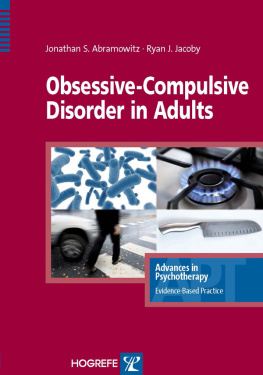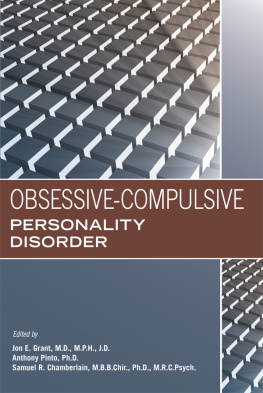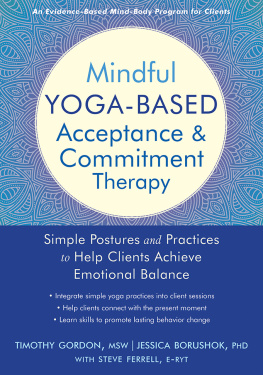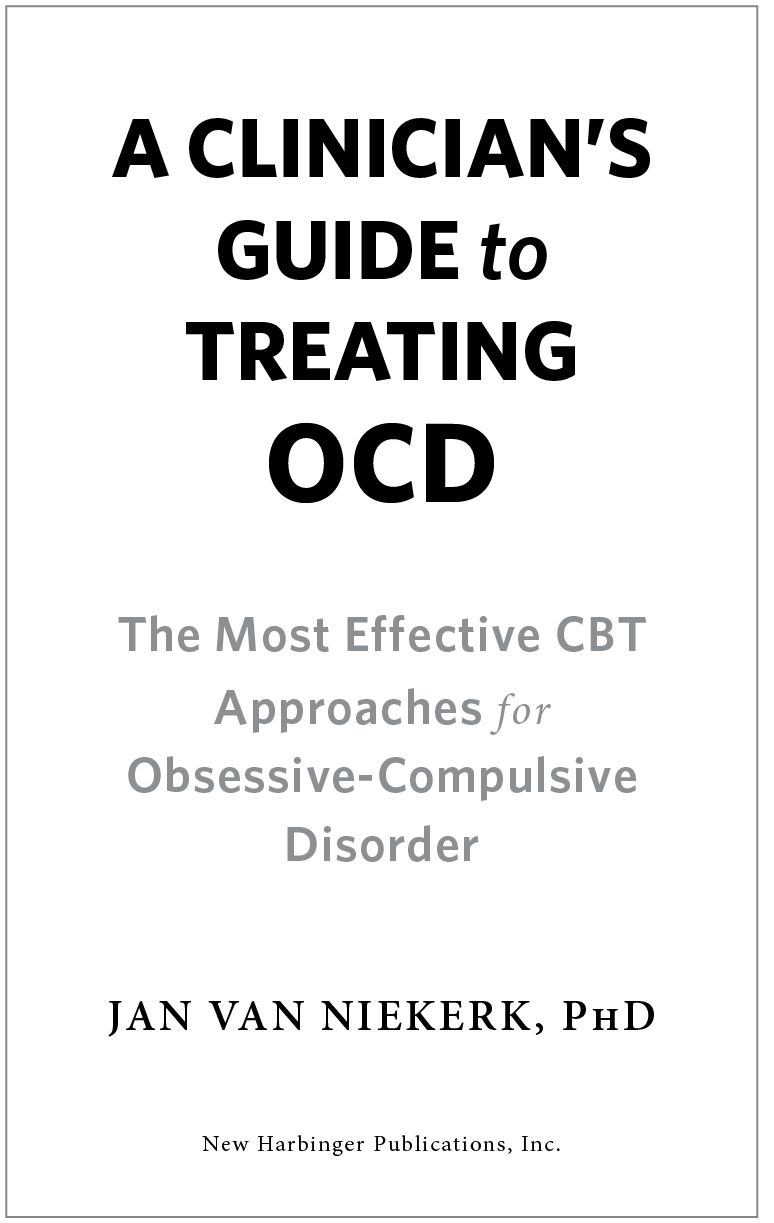A clinicians guide that does just thatno matter where you are in terms of experience of working with people with obsessive-compulsive disorder (OCD), you will find helpful ideas and pointers to guide your understanding and practice. If youre new to working with OCD, this book has all you need to get startedand if youre an experienced clinician theres a wealth of new ideas to refine your expertise. Van Niekerk draws together the most salient aspects of cognitive behavioral therapy (CBT) in its various forms to provide a concise overview of good practice in the treatment of OCD. I like the combination of theory, clinical examples, and practical advice. A great addition to the therapists shelf!
Elizabeth Forrester, PsychD, CPsychol, AFBPsS , consultant clinical psychologist specializing in the treatment of OCD with an independent practice in London, UK; and author of How to Deal with OCD
A Clinicians Guide to Treating OCD by Jan van Niekerk is a clear, readable, and comprehensive guide to current empirically based assessments, conceptions, and treatments for OCD. Each treatment is presented concisely and critically, with all its subtleties and distinctiveness accurately conveyed and amply illustrated through the eyes of a seasoned scholar of the field who is also a master clinician. A must-read, up-to-date guide for clinicians, academics, and students alike.
Kieron OConnor, PhD, MPhil, CPsychol, AFBPsS, FCPA , director of the OCD Spectrum Study Centre at the University Institute of Mental Health at Montreal, and full professor in the department of psychiatry at the University of Montreal
This highly engaging text guides clinicians through five of the most empirically supported psychotherapies for OCD. Each intervention is described in a manner accessible to novice clinicians yet provides insights that seasoned therapists will learn from. A wealth of case examples, transcripts, and worksheets makes this a practical and helpful guide for treating OCD.
Robert Hindman, PhD , faculty at the Beck Institute
Publishers Note
This publication is designed to provide accurate and authoritative information in regard to the subject matter covered. It is sold with the understanding that the publisher is not engaged in rendering psychological, financial, legal, or other professional services. If expert assistance or counseling is needed, the services of a competent professional should be sought.
Inference-based therapy model of obsessive-compulsive disorder adapted from Beyond Reasonable Doubt , OConnor, Aardema, and Plissier. Copyright 2005 by the authors. Used with permission of John Wiley & Sons Ltd.
Invalidating the doubt case examples adapted from Van Niekerk, Brown, Aardema, and OConnor, Integration of inference-based therapy and cognitive-behavioral therapy for obsessive-compulsive disorderA case series. International Journal of Cognitive Therapy, 7 , 6782. 2014. Copyright Guilford Press. Reprinted with permission of The Guilford Press.
Metacognitive Model of OCD, from Cognitive Therapy of Anxiety Disorders , Wells. Copyright 1997 by the author. Used with permission of John Wiley & Sons Ltd.
ACT model of psychopathology adapted from ACT Made Simple , Harris. Copyright 2009 by the author. Used with permission of New Harbinger Publications.
Distributed in Canada by Raincoast Books
Copyright 2018 by Jan van Niekerk
New Harbinger Publications, Inc.
5674 Shattuck Avenue
Oakland, CA 94609
www.newharbinger.com
Cover design by Amy Shoup
Acquired by Jess OBrien
Edited by Rona Bernstein
Indexed by James Minkin
All Rights Reserved
Library of Congress Cataloging-in-Publication Data on file
Contents
Foreword
Obsessive-compulsive disorder (OCD) presents unique challenges to the therapist. It is highly heterogeneous (as quoted in this book, If you have seen one person with OCD, you have seen one person with OCD, p. 1), the internal logic of the OCD system can be elusive to both client and therapist, and the most effective treatment demands of people that they engage in the very behaviors against which they have developed elaborate and highly ingrained avoidance rituals. Treatment can be a difficult sell, and many people feel unable to face it, dropping out at the start. Others attempt treatment but are unable to progress beyond a certain point. Still others simply do not seem to respond to treatment. As such, the actual effectiveness of psychological treatment for OCD remains at a stubborn and unacceptable rate of about 50 percent.
Treatment of OCD presents numerous pitfalls for therapists who have not had a lot of experience with OCD, even if they are highly experienced in other areas. The distress that individuals experience is extremely high, but at the same time, so is the perception of the necessity to engage in the very behaviors that contribute to that distress.
To therapists whose experiences in treating OCD have been unrewarding,
A Clinicians Guide to Treating OCD will be most welcome. This book delivers a crisp, clear, well-informed, and balanced overview of OCD presentation, assessment and formulation, and cognitive-behavioral therapy approaches. Each chapter on treatment offers a highly accessible explication of the theoretical principles underlying the model and a thorough but concise description of treatment strategies.
Written in an authoritative and reassuring tone that will benefit new and experienced therapists alike, this book presents a simplebut not simplisticunderstanding of OCD, why it persists, and how to help people overcome it.
Christine Purdon, PhD, CPsych
Introduction
If this books title caught your attention, I assume you must be interested in learning more about psychological therapy for obsessive-compulsive disorder (OCD). Perhaps you are a psychotherapist trainee or a more experienced therapist seeking to update yourself on the newest developments. The odds are that you have heard of a behavioral therapy method called exposure and response prevention (ERP) treatment or have experience in administering this. ERP, developed in the 1960s, represented a revolution in the treatment of OCD and continues to be the gold standard. When participating in ERP, clients are encouraged to expose themselves to distress-provoking items or situations while holding back from performing rituals or compulsions.
However, given that OCD is such a wide-ranging condition with such unique presentations (if you have seen one person with OCD, you have seen one person with OCD), it is now recognized that ERP has certain limitations: not every person benefits equally. This is why cognitive-behavioral therapy (CBT) practitioners try their best to also understand the cognitions (or thought content and processes) that contribute to OCD. They try to improve on ERP, offering new perspectives and modifications of therapy. The best-developed CBT approach emphasizes the contribution of the persons misinterpretation of intrusive thoughts, experienced by most people, with or without OCD, as suggesting danger or threat. (For clarity, this particular model, and the therapy based on it, will hereafter be referred to as cognitive therapy (CT), even though it falls under the broader heading of CBT.) However, modern CBT encompasses various approaches, and recent developments have seen the introduction of three newcomers: inference-based therapy (IBT), metacognitive therapy (MCT), and acceptance and commitment therapy (ACT).











